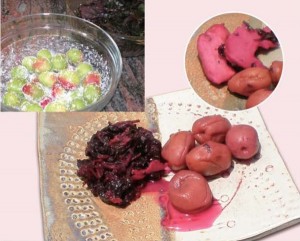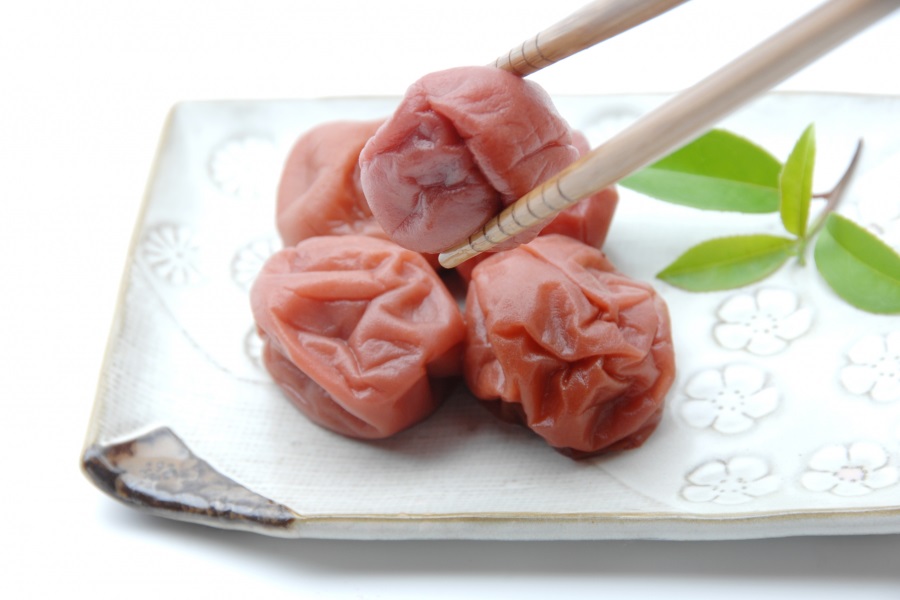Umeboshi, which means pickled plum, is prepared by pickling ume fruit in salt to dry, and then pickling the dried ume in vinegar with shiso leaves. Various types of umeboshi are available, from soft, large ones to crunchy little ones, all having a reddish color. Umeboshi tastes sour on its own, but it has long been a popular side dish in Japan as a perfect accompaniment to rice. With its long history, umeboshi is indeed a traditional Japanese food.
Contents:
History of Umeboshi
Japanese people began making umeboshi during the Heian period (794-1185). As the story goes, a Heian emperor was able to heal himself from an epidemic plague by drinking tea brewed with umeboshi and kombu kelp. While umeboshi was originally considered a medicine for the nobles, the custom of eating umeboshi to cure diseases spread to the samurai class in the Kamakura period (1185-1333), although it was still too expensive for commoners. During the Sengoku (1467-1603) period of civil wars, umeboshi was used on the battlefield as a handy antidote and source of nutrition. It is said that every samurai set out to war with umeboshi hanging from his belt. Commoners finally got their hands on umeboshi in the Edo period (1603-1868) when ume farming became popular. As ume became readily available to the masses, people began pickling ume at home, and umeboshi became a traditional Japanese food, which it remains today.
Known for its distinctive sourness, umeboshi is a popular filling for rice balls in bentos. The antibacterial effects of umeboshi are believed to prevent food poisoning, as bentos are often eaten long after the food is prepared. A rich source of natural citric acid, umeboshi is also believed to relieve fatigue, prevent aging, and offer other wonderful health benefits if eaten daily. Another common belief is that drinking plenty of bancha tea with umeboshi soaked in it is a great cure for hangover.
Let’s Make Umeboshi
Let’s make umeboshi in ume season! Use fully ripe ume. Ripe ume assumes a yellowish hue and releases a pleasant aroma. If you bought ume that aren’t yet yellow, keep them at room temperature for a couple of days to ripen.
Umeboshi Recipe

Ingredients (Serves approx. 2 cups)
- 2-1/4 lb. ripe ume
- 6-1/4 oz. sea salt (18% of ume by weight)
- 3-1 /2 to 7 oz. red shiso leaves (10 to 20% of ume by weight)
Cooking Directions
- Wash ume and soak them in water overnight.
- Dry the ume, spray with shochu, Japanese distilled liquor, and sprinkle with salt. Place a 4-1 /2 lb. weight on top, and wait for a week or so until the juice (ume vinegar) is extracted from the ume. (A).
- Rub salt into red shiso leaves, soak them in water to release the bitterness, and wring them dry. Spread the shiso leaves over the ume, pour the ume vinegar from (A), and wait for the “dog days of summer.” As we say, “Three days, three nights of doyoboshi.” Hang the ume to dry over several consecutive days of fine weather.
What you need
- Pickling jar (made of glass, ceramic, or enamel), weights.
- Before using the jar and weights, sterilize them in boiling water.
What is Doyoboshi?
Doyoboshi refers to the custom of drying things for “three whole days,” or three days and three nights, from July 20 to July 23 that usually coincide with the dog days of summer. The amount of ultraviolet radiation reaches its peak during the dog days. Our ancestors knew from experience that drying things under the sun during this period would prevent the formation of mildew.

